Rose properties: do you know them?The Rosaceae family includes many species, the most famous of which are Rosa Canina, Rosa gallica, Rosa centifolia, Rosa Mosqueta, Rosa Damascena. Let’s find out their use in herbal medicine and cosmetics.
Rosa, from its Greek name rodon, or right De Theis from a Celtic root, which means red, is a genus of the Rosaceae family that includes about 150 species, native to Europe and Asia. It includes bushy, sarmentose, climbing, creeping species, shrubs and saplings, achene fruits contained in a false fruit (rosehip).
As for the classification, among the “botanical roses”, the best known species that grow spontaneously are Rosa gallica and canina; among the “ancient roses”: the most common species are rosa gallica, centifolia, damascena. DNA tests of Rosa gallica (or “red rose of Lancaster”) showed that it was the mother of Damascena, Alba and Centifolia roses.
Rose-based preparations for cosmetic or therapeutic purposes have been known since ancient times. There is no lack of citations by Pliny (Nat. Hist. 21.14), Aulus Gellius (Gell. 14.6), Celsio (Gell. 14.6; Cels. De Medicina 8.3.), Horace (Carmina 1.5.1 and 2.11.14), Ovidio (in Medicamina faciei femineae, he reports the recipe based on Rose as a skin lightener (91-98)). In 19th century pharmacopoeias and phytotherapy texts, the species of Rose used for therapeutic purposes were R. canina and R. gallica, R. centifolia and R. damascena. Their use was indicated above all as a purgative.
Rosa Canina: properties and use
Rosa canina is the most common species of wild rose in Italy, very common in hedges and at the edge of the woods. It is sometimes called the maquis rose or wild rose. The term rose has a Celtic origin and means red, while the word canine derives from the ancient belief that the root of this plant was used to cure the anger of dogs and people injured by their bites (Pliny the Elder).
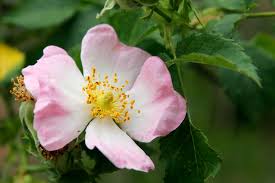
Dog rose blooms from May to July, berries ripen in October-November. The false fruit of the dog rose is characterized by a red color and a fleshy consistency; it is edible but sour and not palatable fresh. It derives from the modification of the floral receptacle and contains within it achenes. The achenes are the real fruits of the dog rose, they derive from the modification of the carpels and each of them contains a seed. The structure as a whole (1 or 2 cm) is called a rosehip. The parts usually used are:
- false fruits: they are the skins of the Rose Hips emptied of woody fruits and stinging hairs that represent the true vegetable drug of the Rosa canina. Once dried, they have been shown to contain a high dose of natural and bioavailable vitamin C together with carotenoids, flavonoids, pectins, tannins and anthocyanins. Not all species of wild roses then have the same content of Vitamin C. The extracts of Rosa canina titrated and standardized in Vitamin C are the only ones that guarantee the availability of the vitamin and allow a certain functionality in the skin. The advantages of using a Rosa canina extract compared to the vitamin C used in its pure state is that the extract is more bioavailable for redox activity due to the presence of carotenoids and flavonoids, which improve and synergize radical scavenger efficacy of vitamin C.
Rosehip fruit dry extract tit. 70% in vitamin C is commonly used by herbalists as a source of vitamin C and in particular to strengthen the immune system, and is for example present in the formulation of our Fitosostegno syrup and Fitosostegno Junior syrup. With the fruits, mother tincture and other extracts are also made. In cosmetics, Rosa canina uses the dry extract of false fruits titrated in vitamin C with everything that involves the use of the vitamin in the cosmetic field (antiaging, radical scavenger activity, increase in the share of native collagen, lepismatic, etc. etc.). );
- fresh petals of the rose can generally be used as follows:
1) by infusion taking advantage of their refreshing and astringent properties of the tannic substances present and can therefore find a certain use in tonics for delicate skin;
2) by extracting the anthocyanins present in the colors of the petals and exploiting for their capillary-protective properties, reinforcing the microcirculation and antioxidants, also in the cosmetic field (due to the antioxidant action, capillary fragility, anticollagenase, antijaluronidasica etc.).
The polychromy of rose petals in general goes from white to red through an infinite variety of shades. This color is produced by two classes of pigments: carotenoids (mostly contained in white and yellow roses) and anthocyanins (ranging from pink to bright red petals) belonging to the large group of flavonoids. The obtaining of the anthocyanins can be obtained by subjecting the rose petals to maceration in a mixture of water and alcohol at an appropriate strength and then concentrating until the solvent is eliminated.
- young dog rose shoots are used in herbal medicine to produce glyceric macerate or Rosa canina bud extract (see also the post “Rosa canina bud extract, the properties to know”).
The Gallic Rose: properties and uses
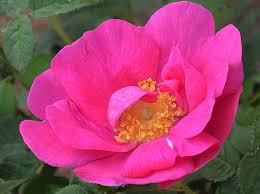
Imported to Europe in the 13th century from the East, by the Crusader Thibault IV Count of Champagne, of Rosa gallica (also known as red rose or Austrian rose) the petals and buds are used to be gathered when they begin to open. The main constituents, reported by Dr. Valnet in his writings are essential oil, gallic acid, tannin (15%) and antibiotic principles. Properties: astringent, healing and fortifying. The dott. Valnet also indicates some recipes with Rosa gallica: rose jam (750 grams of sugar, 250 grams of fresh buds, add rosy water to obtain a honey-like paste; rosé vinegar (dried red rose petals 60 gr, strong red vinegar 750 gr, let soak 1 week shaking occasionally, pass and filter, use for gargle 1-2 soup spoon per glass of hot water, against mouth ulcers, eye drops or mouth rinses in case of stomatitis (2- 3 pinches of petals for a cup of boiling water, infuse for 10 minutes.
With the distillation of gallic rose flowers, rose water (or rose hydrolate) is obtained from the hydrosolic portion, used since ancient times for the preparation of lotions and as a mild astringent.
The Bulgarian Rose or Damascena: properties and use
There are only two places in the world where climate, soil and other ecological factors have favored the development of this rose, queen of all for its heady scent: the “Valley of the Roses” in Kazanlik in Bulgaria and the Isparta valley in Turkey. In Isparta is the place where today the highest perfume rose production in the world is concentrated. Because of the very expensive production process and the low oil content in rose petals, rose oil has a very high price (just think that a rosebud contains only about 0.02% of essential oil and that a drop of pure essential oil is the equivalent of 60 roses).
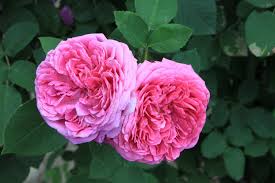
There are three main methods of extracting oil from the plant material: steam distillation (the flowers are harvested by hand in the morning before dawn and the material is distilled the same day), which produces the oil essential real or pure rose essence, also called eight rose or attar of roses; the extraction with solvent or with super critical carbon dioxide, which results in an oil called absoluto di rosa. From the distillation of 100 kg of fresh damask rose flowers with solvent, about 10 g of absolute (or absolute oil) is obtained. The rose absolutes better represent the aroma of the rose flower because they contain high percentages of water-soluble compounds, especially 2-phenyl-ethyl-alcohol, which give characteristic notes to the aroma. Absolutes are often marketed as rose oils, but it is important to emphasize that they are not.
During the distillation process, large stills, traditionally in copper, are filled with roses and water. A fire is lit under the still for 60-105 minutes. The vaporized water and the rose essential oil come out of the alembic and enter a condensing apparatus and are then collected in a flask. This destination leads to a very concentrated oil, the direct oil, which makes up about 20% of the final product. The water that condenses together with the oil is separated and distilled again, by coobation, in order to obtain water-soluble rose oil fractions such as phenethyl alcohol, a vital component of the aroma that makes up the bulk, about 80% of the oil. The two oils are combined and create the final eight rose (pure rose essential oil). An important trace component of rose oil is ß-damascenone which, despite its very low concentration (0.01%), has a significant influence on the quality of the essential oil: together with compounds such as ß-damascone and ß- ionone, formed by enzymatic degradation from the carotenoids present in the petals! The essence has a very strong smell, but it is pleasant as it is diluted and used as a perfume.
The only essential oil of Rosa damascena that should be used by professional aromatherapists, write the aromatherapists Shirley Price and Len Price in the book “Treatise on aromatherapy”, it is the essence of pure roses, that is the essential oil obtained by steam current distillation , with a less sweet aroma than the absolute one obtained by distillation with solvent. The essence of roses has astringent, anti-haemorrhagic, healing, hormone-like and neurotonic properties. In perfumery, instead, Bulgarian Rose is mainly used for the absolute of rose, which gives the fragrance to the product.
The hydrosolic portion of this distillate of damask rose flowers is always the famous rose water (or rose hydrolate), used for the skincare; in herbal medicine, damask rose petals are useful as a mild laxative indicated in case of constipation. It can be used as a syrup or as an infusion (30 g per half liter of boiling water to be infused for 10 minutes and drink 2-3 cups a day. (J. Valnet, Fitoterapia, 2007).
Rosa rubiginosa (Rosa mosqueta of Chile): properties and uses
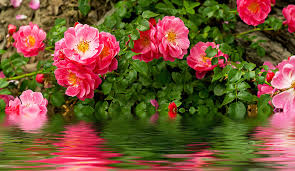
From the Rosa Rubiginosa, wild rose native to the Andes, mainly in Chile and Peru, and better known as Rosa Mosqueta, it is obtained by pressing the cold-pressed fruits (the seeds, which represent about 70% of the weight of the fruit) a rich oil in poili-unsaturated fatty acids, Rosa Mosqueta oil. Golden red in color, it has high levels of linoleic acids (44% of the main composition, polyunsaturated with two double bonds) and linolenic acid (33% of the main composition, polyunsaturated with three double bonds), oleic acid (15% of the main composition, monounsaturated with double bond), together with significant amounts of vitamin C. It also contains a small percentage of trans-retinoic acid, which contributes to its therapeutic properties. Studies conducted in Chile have highlighted that it regenerates tissues and reduces the signs of premature aging and wrinkles, as well as mitigating scars. These properties make Rosa Mosqueta oil an active product in cell regeneration, with excellent results in maintaining freshness, preventing and reducing wrinkles.
It has been shown that topical application of these polyunsaturated fatty acids contained in rose oil improve the protection of the skin against harmful external agents such as sun, smog, cold etc. and slow down the aging process caused by excessive evaporation of water. In fact, as we age, our skin tends to become drier and it seems that this is connected with the loss of that fatty cementing material that is found in the intercellular spaces of the more superficial epidermal cells and whose integrity is fundamental. importance to counteract excessive water losses from the deeper skin layers. In order for this natural barrier to form, it is essential that our diet is rich in polyunsaturated fatty acids. However, as we age, our body may not be able to make the best use of these fats and one of the obvious consequences may be excessive dehydration of the skin with the formation of many annoying small lines on the face.
Marco Valussi, in his book “the great manual of aromatherapy” recommends rosehip oil (rich in AGL, linolenic acid, oleic and palmitic) for dry, flaky and fissured skin, psoriasis, eczema, pigmented skin, scars; also useful after sunburn, trauma, varicose veins. Avoid in case of oily and acneic skin; do not keep the bottle open for a long time otherwise it becomes rancid quickly (if natural!) use at 10% or 100% in dry and aged skins.
Rosa centifolia: properties and uses
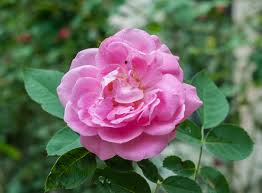
It is mainly cultivated in the Dadès valley in the El Kalaat M’Gouna region of Morocco, a middle region between the snows of the Atlas on one side and the torrid Sahara sun on the other.
This variety of small and very delicate roses forms tall and thick bushes up to 3 meters high with branches bristling with lateral thorns. The flowering tops bear pink flowers with small corollas dense with petals. The very delicate flowers, during the harvesting period, must be manually removed one by one and it takes about 500kg of fresh roses (almost 100,000 flowers) to obtain just one kg of concrete.
Once the rose buds have been harvested, two procedures are followed to treat the roses:
1) extraction with hexane type solvents or petroleum ether in which the solvent by direct contact with the petals absorbs the aromatic elements present in the fresh buds. The solvent is then removed
by distillation to finally obtain a wax called “concreta“, a combination of essential oils and waxes. The concrete is passed into the alcohol to remove the wax, then into the refrigerator so that it coagulates. Finally it is filtered and the alcoholate is obtained. For subsequent distillation of the alcoholate the pure essence called absolute is obtained.
2) indirect distillation in copper stills to obtain the essence of roses (500kg of roses per 2500 liters of water).
The most requested product in this case by perfumers is the concrete because it preserves the original fragrance better. This Rosa Centifolia concrete is used in cosmetics / perfumery to complete the fragrance of the absolute of Bulgarian Rose; waxes and carotenes are used, which remain from the concrete once the absolute has been extracted with alcohol as substitutes for cetyl alcohol in creams.
For any clarification or for more information Contact us.
Follow us on our Facebook and Instagram channels
ALL RIGHT ARE RESERVED, THIS TEXT IS NOT REPRODUCIBLE WITHOUT EXPRESS AUTHORIZATION OF ERBORISTERIA COMO

